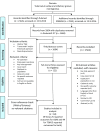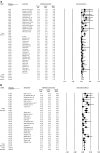The endoscopic endonasal approach is not superior to the microscopic transcranial approach for anterior skull base meningiomas-a meta-analysis
- PMID: 29127655
- PMCID: PMC5735207
- DOI: 10.1007/s00701-017-3390-y
The endoscopic endonasal approach is not superior to the microscopic transcranial approach for anterior skull base meningiomas-a meta-analysis
Abstract
Object: In the past decade, the endonasal transsphenoidal approach (eTSA) has become an alternative to the microsurgical transcranial approach (mTCA) for tuberculum sellae meningiomas (TSMs) and olfactory groove meningiomas (OGMs). The aim of this meta-analysis was to evaluate which approach offered the best surgical outcomes.
Methods: A systematic review of the literature from 2004 and meta-analysis were conducted in accordance with the PRISMA guidelines. Pooled incidence was calculated for gross total resection (GTR), visual improvement, cerebrospinal fluid (CSF) leak, intraoperative arterial injury, and mortality, comparing eTSA and mTCA, with p-interaction values.
Results: Of 1684 studies, 64 case series were included in the meta-analysis. Using the fixed-effects model, the GTR rate was significantly higher among mTCA patients for OGM (eTSA: 70.9% vs. mTCA: 88.5%, p-interaction < 0.01), but not significantly higher for TSM (eTSA: 83.0% vs. mTCA: 85.8%, p-interaction = 0.34). Despite considerable heterogeneity, visual improvement was higher for eTSA than mTCA for TSM (p-interaction < 0.01), but not for OGM (p-interaction = 0.33). CSF leak was significantly higher among eTSA patients for both OGM (eTSA: 25.1% vs. mTCA: 10.5%, p-interaction < 0.01) and TSM (eTSA: 19.3%, vs. mTCA: 5.81%, p-interaction < 0.01). Intraoperative arterial injury was higher among eTSA (4.89%) than mTCA patients (1.86%) for TSM (p-interaction = 0.03), but not for OGM resection (p-interaction = 0.10). Mortality was not significantly different between eTSA and mTCA patients for both TSM (p-interaction = 0.14) and OGM resection (p-interaction = 0.88). Random-effect models yielded similar results.
Conclusion: In this meta-analysis, eTSA was not shown to be superior to mTCA for resection of both OGMs and TSMs.
Keywords: Complications; Endoscopic transsphenoidal surgery; Gross total resection; Meta-analysis; Microscopic transcranial surgery; Olfactory groove meningioma; Tuberculum sellae meningioma.
Conflict of interest statement
Conflict of interest
All authors certify that they have no affiliations with or involvement in any organization or entity with any financial interest (such as honoraria; educational grants; participation in speakers’ bureaus; membership, employment, consultancies, stock ownership, or other equity interest; and expert testimony or patent-licensing arrangements), or non-financial interest (such as personal or professional relationships, affiliations, knowledge or beliefs) in the subject matter or materials discussed in this manuscript.
Human participants
This article does not contain any studies with human participants performed by any of the authors.
Ethical approval
Ethical approval was not necessary because of the nature of the study (meta-analysis).
Informed consent
Not applicable as this study did not involve individual patient data.
Figures




Comment in
-
The endoscopic endonasal approach or microscopic transcranial approach for anterior skull base meningiomas-It is all about right indication rather than superiority.Acta Neurochir (Wien). 2020 Jan;162(1):77-78. doi: 10.1007/s00701-019-04080-3. Epub 2019 Nov 6. Acta Neurochir (Wien). 2020. PMID: 31691852 No abstract available.
-
The endoscopic endonasal approach or microscopic transcranial approach for anterior skull base meningiomas-it is all about right indication rather than superiority.Acta Neurochir (Wien). 2020 Jan;162(1):75-76. doi: 10.1007/s00701-019-04085-y. Epub 2019 Nov 19. Acta Neurochir (Wien). 2020. PMID: 31745623 No abstract available.
Similar articles
-
The endoscope-assisted supraorbital "keyhole" approach for anterior skull base meningiomas: an updated meta-analysis.Acta Neurochir (Wien). 2021 Mar;163(3):661-676. doi: 10.1007/s00701-020-04544-x. Epub 2020 Sep 5. Acta Neurochir (Wien). 2021. PMID: 32889640 Free PMC article.
-
Olfactory groove and tuberculum sellae meningioma resection by endoscopic endonasal approach versus transcranial approach: A systematic review and meta-analysis of comparative studies.Clin Neurol Neurosurg. 2018 Nov;174:13-20. doi: 10.1016/j.clineuro.2018.08.029. Epub 2018 Aug 28. Clin Neurol Neurosurg. 2018. PMID: 30193170
-
Tuberculum sellae meningiomas: grading scale to assess surgical outcomes using the transcranial versus transsphenoidal approach.Neurosurg Focus. 2018 Apr;44(4):E9. doi: 10.3171/2018.1.FOCUS17753. Neurosurg Focus. 2018. PMID: 29606045
-
Endoscopic endonasal versus open transcranial resection of anterior midline skull base meningiomas.World Neurosurg. 2012 May-Jun;77(5-6):713-24. doi: 10.1016/j.wneu.2011.08.025. Epub 2011 Nov 7. World Neurosurg. 2012. PMID: 22120296 Review.
-
Pure endoscopic expanded endonasal approach for olfactory groove and tuberculum sellae meningiomas.J Clin Neurosci. 2014 Jun;21(6):927-33. doi: 10.1016/j.jocn.2013.10.015. Epub 2013 Nov 4. J Clin Neurosci. 2014. PMID: 24433951 Review.
Cited by
-
Keyhole supraorbital eyebrow approach for fully endoscopic resection of tuberculum sellae meningioma.Front Surg. 2022 Sep 7;9:971063. doi: 10.3389/fsurg.2022.971063. eCollection 2022. Front Surg. 2022. PMID: 36157417 Free PMC article.
-
A Low Subfrontal Dural Opening for Operative Management of Anterior Skull Base Lesions.J Neurol Surg B Skull Base. 2022 May 3;84(3):201-209. doi: 10.1055/a-1774-6281. eCollection 2023 Jun. J Neurol Surg B Skull Base. 2022. PMID: 37180868 Free PMC article.
-
Predictive model for preoperative risk calculation of cerebrospinal fluid leak after resection of midline craniofacial mass lesions.World Neurosurg X. 2023 Jan 25;18:100163. doi: 10.1016/j.wnsx.2023.100163. eCollection 2023 Apr. World Neurosurg X. 2023. PMID: 36818738 Free PMC article.
-
Anterior Skull Base Meningioma: Surgical Approach and Complication Avoidance.J Neurol Surg B Skull Base. 2022 Feb 14;84(1):38-50. doi: 10.1055/a-1733-9320. eCollection 2023 Feb. J Neurol Surg B Skull Base. 2022. PMID: 36743714 Free PMC article.
-
Skull base repair following endonasal pituitary and skull base tumour resection: a systematic review.Pituitary. 2021 Oct;24(5):698-713. doi: 10.1007/s11102-021-01145-4. Epub 2021 May 10. Pituitary. 2021. PMID: 33973152 Free PMC article.
References
-
- Ali MZ, El-Mekawi S, Al-Azzazi A. Tuberculum sellae meningiomas: surgical results and outcome in 30 cases. Egyptian J Neurol, Psychiatry Neurosurg. 2010;47:549–554.
-
- Banu MA, Mehta A, Ottenhausen M, Fraser JF, Patel KS, Szentirmai O, Anand VK, Tsiouris AJ, Schwartz TH. Endoscope-assisted endonasal versus supraorbital keyhole resection of olfactory groove meningiomas: comparison and combination of 2 minimally invasive approaches. J Neurosurg. 2016;124:605–620. doi: 10.3171/2015.1.JNS141884. - DOI - PubMed
Publication types
MeSH terms
LinkOut - more resources
Full Text Sources
Other Literature Sources
Medical
Miscellaneous

